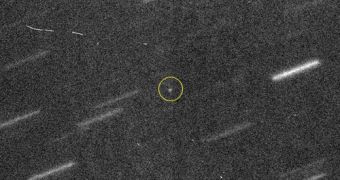There are plenty of asteroids, even huge ones, fling by Earth. For the most part, they're seen a long time coming, though some smaller ones still manage to take us by surprise by being discovered while they're relatively close to Earth.
No known and tracked asteroid poses any danger to Earth and you can add asteroid 2011 AG5 to the list. Astronomers have seen enough to know that the asteroid will fly safely by once it gets near to our planet, 28 years from now.
So doomsday fans let down by 2012's disappointing apocalypse will have to look elsewhere for the next end of the world scenario.
When the asteroid was first discovered, last year as suggested by its name, scientists estimated that there was a 1-in-500 chance of the asteroid being on a collision course with Earth.
It's not particularly huge asteroid, but at 140 meters (460 feet), it could cause quite a lot of damage.
After several months of observations, astronomers have managed to narrow down the area through which the asteroid will pass in 2040.
It will only get as close as 900,000 km (550,000 miles) to the Earth, more than twice the distance to the Moon.
Considering that it's such a small asteroid, making it very hard to see that far out, and that it will take 28 years of flying at a high speed to reach us, the accuracy of the prediction is impressive.
There's still a chance that astronomers could be wrong and they're still keeping an eye on the asteroid.
It will pass by Earth in 2023, at about 1.8 million km (1.1 million miles) and it could pass by what is dubbed a keyhole, a region about 365 km (227 mile) wide.
If that happens, its orbit could be altered enough for it to enter an impact course for 2040, but there's a very remote chance of that.

 14 DAY TRIAL //
14 DAY TRIAL // 
